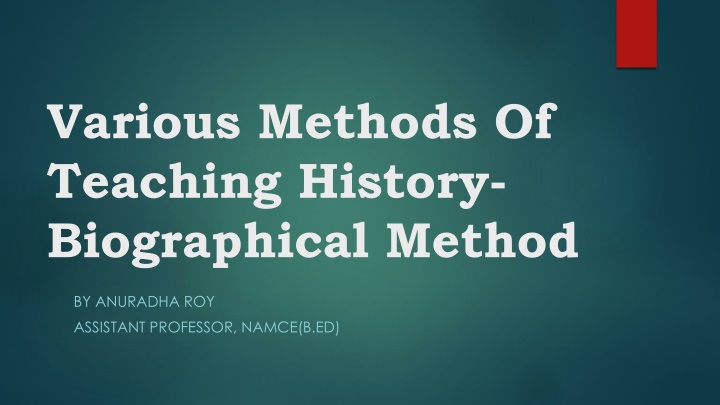
Unique Methods of Teaching History | Biographical Approach by Anuradha Roy
Explore the Biographical Method of Teaching History by Anuradha Roy, an Assistant Professor, which involves using original sources like literary, oral, and archaeological resources to enhance understanding. Learn about the classification of sources, advantages, and disadvantages of this educational approach.
Download Presentation

Please find below an Image/Link to download the presentation.
The content on the website is provided AS IS for your information and personal use only. It may not be sold, licensed, or shared on other websites without obtaining consent from the author. If you encounter any issues during the download, it is possible that the publisher has removed the file from their server.
You are allowed to download the files provided on this website for personal or commercial use, subject to the condition that they are used lawfully. All files are the property of their respective owners.
The content on the website is provided AS IS for your information and personal use only. It may not be sold, licensed, or shared on other websites without obtaining consent from the author.
E N D
Presentation Transcript
Various Methods Of Teaching History- Biographical Method BY ANURADHA ROY ASSISTANT PROFESSOR, NAMCE(B.ED)
Meaning Of Source Method Source Method implies using original material and sources in the teaching and learning of history. By providing first hand experience this method leads to better understanding of the subject.
Classification Of Sources Sources may be classified as----- Literary Resources--- Sources may be classified as Primary Sources Physical Remains: Historical cities, clothing, human jewels, pottery, utensils, building, furniture, weapons, museums, portraits coins, stamps, historical paintings Oral or Written Testimonies: Oral: Stories, anecdotes Written : Wills, affidafits, permits, licenses, bills, magazines Secondary Sources There are those document which are written by those who are not in the scene of the event. May be the participant of that event or eye witness Many history textbooks and encyclopaedia are examples of secondary sources. a. a. Religious Literature Hindu Literature Buddhist Literature Jain Literature Secular Literature Writings by foreigners Bio-graphical works by historical persons and texts Literary Compositions b. Archeological Resources--- Inscriptions Coins Monuments, remnants of cities, art, pieces, potteries etc.
Use Of Source Method Pre lesson Uses: Visits to actual sites of monuments/forts/museums or teacher can ask them to read some selected pages. Mid Lesson Uses: During the lesson the teacher may arrange real time situation Post Lesson Uses: Teacher may given assignments which need to use the resources, they may be encouraged to pursue their interest in a particular topic. Do some critical thinking and analysis & prepare their own account.
Advantages It would make historical facts appear real It provides an opportunity to the pupils to learn history (Visiting museums, actual handling) The source method offers groupwork, workshop regarding particular material This method gives the pupil insight into the process of gathering historical facts so that they can develop historical senses This method is suitable for higher and lower classes. The source method make the subject history more concrete and more meaningful
Disadvantages Original sources are sometimes not available for India Source method is quite lengthy Source method is too complex and technical
